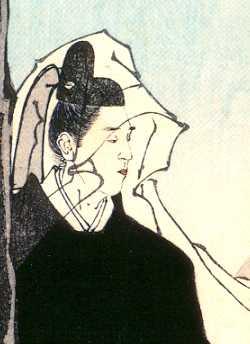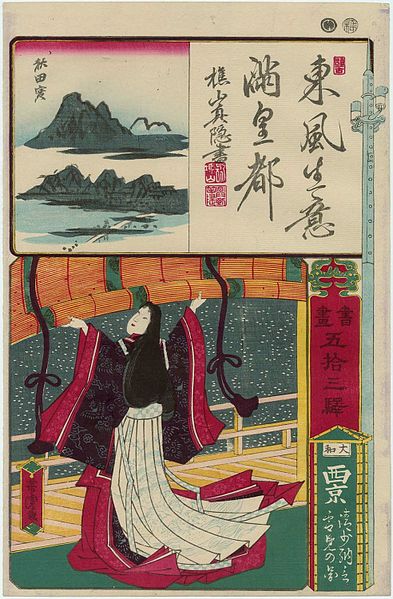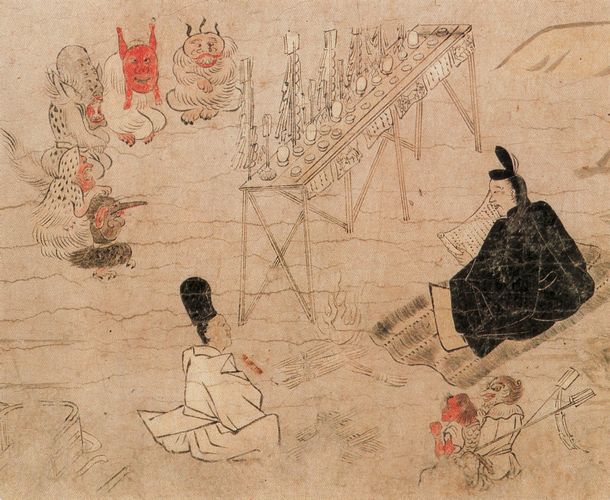 Just before boarding my flight to Japan (this time for a two-month internship in Kumamoto prefecture – update will follow!), I would like to share another part of my Master’s thesis on mental health stigma with you. If you are new to this series of blog posts, feel free to check out part 1, 2, 3, 4, 5 first before getting into this one. Part 6 is dedicated to the performance arts, nōgaku and kyōgen in particular, and how these represented “madness” in premodern Japan.
Just before boarding my flight to Japan (this time for a two-month internship in Kumamoto prefecture – update will follow!), I would like to share another part of my Master’s thesis on mental health stigma with you. If you are new to this series of blog posts, feel free to check out part 1, 2, 3, 4, 5 first before getting into this one. Part 6 is dedicated to the performance arts, nōgaku and kyōgen in particular, and how these represented “madness” in premodern Japan.
Nōgaku indicates two theater forms developed from Sarugaku during the 14th century, Nō 能 and Kyōgen 狂言. Nō is a musical performance art that presents famous tales and legends by making use of masks and a limited amount of props on stage. Nō performances are full of symbolism and often feature supernatural elements. One leitmotiv in several Nō pieces is monogurui 物狂[1], a theatrical element representing “madness”. It can be said that Nō plays of the monogurui type are constructed around a central concept of “possession” as a sacred phenomenon[2]. Monogurui has multiple meanings: it does “not only indicate the condition in which one loses mental equilibrium, but also refers to (a) a person in such a condition or (b) such a display of madness in a performance[3]”.
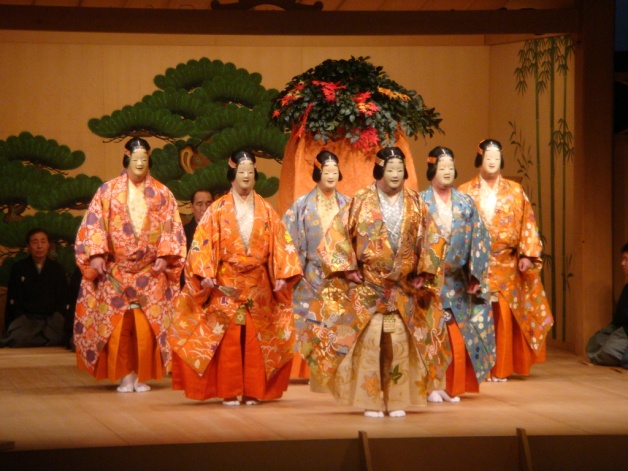
a Nō performance – blogs.yahoo.co.jp
A state of monogurui is caused by a psychological crisis and is in many cases expressed in the form of a “mad dance”. In this instant of “madness”, the protagonist, in almost all plays of monogurui Nō a woman, reveals her suppressed feelings. According to Zeami, “madwomen” (kyōjo 狂女) were the ideal material for an interesting play, because “women are mysterious beings by nature”[4]. Two triggers of monogurui can be identified: spirit possession (tsukimono 憑物), or excessive affection because of the loss of a loved one (omoi 思ひ)[5]. From an objective point of view, the “madwoman” as represented in Nō, tormented by a spirit or by immense grief, has a reason to act insane. The “mad dance”, the climax of monogurui, functions here as a visual representation of mental suffering and as a dramatic tool to evoke sympathy from the audience[6]. This indicates not only a high level of spirituality, but also a strong influence of Buddhism and Shintoism.
For example, in Lady Aoi (Aoi no Ue 葵上), a play loosely based on the possession scene in The Tale of Genji as described in a previous post, the evil spirit that possesses Lady Rokujō and haunts Aoi, is exorcised by sacred prayers. After her soul has been cleansed of jealousy, Lady Rokujō is capable of reaching enlightenment. In the pictures below, the anger of Lady Rokujō is expressed through her transformation into a demon. Although the play is named afer her, Lady Aoi never appears on stage: she is represented by an empty kimono. Hence, the focus is on the possessed Lady Rokujō throughout the play.
Other examples of Nō plays featuring monogurui are Mii-dera Temple三井寺, Hanjo 班女, Hyakuman The Dancer (Hyakuman 百万), The River of Cherry Blossoms (Sakuragawa 桜川), The Reed Cutter (Ashikari蘆刈), Sumidagawa River隅田川, Flower Basket (Hanagatami花筐), and Pining Wind (Matsukaze 松風) [7] . Monogurui in Nō resembles in many aspects the mono no ke concept from the Heian period. Both target “weak” women, are caused by psychological instability, are dramatic techniques to enable the protagonist to freely express their otherwise suppressed feelings, and bear a strong connection with religion and spirituality. Nevertheless, it is important to keep in mind that this embellished idea of “madness” is one dominantly perceived on stage or in literature; “during the Middle Ages, such behavior would certainly have been a frightful sight in real life[8]”.

Sumidagawa 隅田川 is a well-known example of a “madwoman’s play” – Wikiwand
The second theatrical form of Nōgaku, Kyōgen, does not use masks nor music. The plays are comical sketches, traditionally staged between Nō plays. As much as Nō is connected with spirituality, Kyōgen is intrinsically linked with “earthiness”, with its performance in vulgar language and satirical representation of daily events in common people’s life. Although the expression of “madness” is not as obvious as in Nō, there are multiple plays in which the characters act unconventionally, or are called “crazy” by others. “Madness” in Kyōgen is irrational; no clear incentive is given. Its absurdity, “playful lunacy [9]” in a sense, is staged not to evoke compassion, but laughter.
The representation of “madness” in Kyōgen appears to be closer to mental disorders in real life[10], an impression supported by the fact that the word kyōgen actually means “mad words”. Another significant observation is that the word monogurui 物狂 designates the Japanese reading for 狂 (kuru-i), while kyōgen狂言prescribes the Sino-Japanese pronunciation for the same character狂 (kyō). Moreover, when “madness” is directly expressed in a Kyōgen play, the word bukkyō 物狂 is mostly used, which is the Sino-Japanese reading for 物狂. For example:
- なう、そなたのなりは物狂や、何事ぞいなう。(Nau, sonata no nari ha bukkyō ya, nanigoto zo inau.) From Mr. Dumbtarō (Dontarō 鈍太郎). translation: “Come now, you look like crazy, how scandalous!”
- のう、物狂や物狂や、何とわらわが名などが付けらるるものじゃ。(Nō, bukkyō ya bukkyō ya, nani to warawaga mei nado tsukeraruru mono ja.) Translation: “This is madness, it’s madness, what for a name am I getting now” From Bikusada Gets Named (Bikusada 比丘貞)
- 「なうなうおぢやれ,物いはう」「ああ物狂や」(“nau nau odjare, mono ihau” “aa bukkyō ya”) Translation: “Here here, come on in, let us talk!” “You’re insane!” From The Second-Class Master Blindman and the Monkey(Saru Zatō 猿座頭). [11]
The speaker in this play directly criticizes the appearance or action of the other or the “crazy” situation they are in, a nuance completely absent in Nō theater. Both forms of Nōgaku have a different interpretation of “madness”, which can be observed in the different terminology they utilize. Although spelled the same, when read Monogurui, it is used in the sacred, ritual and highly stylized context of Nō, while the pronunciation bukkyō is associated with Kyōgen, the theater form strongly connected with the ordinariness and vulgarity of everyday life [12]. A similar distinction between the two readings of bukkyō/monogurui can also be found back in other text dating back to roughly the same time Nōgaku was in vogue. While mongurui appeared almost exclusively on stage and in a ritual or religious context, bukkyō is a common description of “madness” in everyday life, used to express the speaker’s feelings of annoyance and vexation towards the aberrant behavior of someone else [13].

Foreword to the Sand and Pebbles – Wikimedia Commons
For example, in the work Sand and Pebbles (Shasekishū 沙石集, 1283), “mad” people are referred to as bukkyō no mono 物狂の者. Sand and Pebbles is a collection of Buddhist parables by Mujū Ichien無住一圓, “small talk reflecting the lifestyle and feelings of the general populace in the far Eastern region at that time[14]”. The influence of Kyōgen is visible in the plain and popular reciting style as well as in the humorous notes. The Rise and Decline of the Minamoto and Taira Clans (Genpei Jōsuiki 源平盛衰記, 14th Century), an extended version of The Tale of the Heike, uses bukkyō as to indicate aberrant behavior (bukkyō no hito ni te,…物狂の人にて、…[15]). A last example is from the Kenmu Code (Kenmu Shikimoku建武式目). One article promulgating “matters that should be economized” argues that wearing luxurious and flashy clothes should be strictly regulated. Such inappropriate attire is called “extreme madness” (sukoburu bukkyō 頗る物狂) and thus heavily criticized[16].
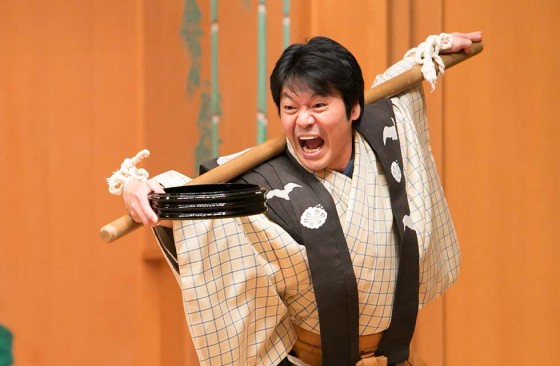
Manzo Nomura, a famous Kyogen actor – Asia Society
One scholar mentions that during the Japanese middle ages, the difference between sane and insane was only a matter of the cultural value attached to these concepts. Nevertheless, he warns, what was once tolerated in ancient society was now being identified as “madness”[17]. In short, there existed different interpretations of “madness”, and two of these interpretations (one highly stylized as an art form, one criticized and laughed at in daily life) were acted out on stage in Nō and Kyōgen.
Footnotes & References
[1] Zeami expressed in his theoretical work The Flowering Spirit (Fūshikaden風姿花伝) his preference for this type of Nō: “it is the most fascinating form of Sarugaku theater.” Matsuo, Kōichi 松尾恒一. From Ritual to Art. Mania, Possession and Jest. 儀礼から芸能へ. 狂騒・憑依・道化 (girei kara geinō he. kyōsō・hyōi・dōke) Kadokawa Series 54. Tokyo: Kadokawa Gakugei Publishing, 2011, p. 110. [2] Oda, Susumu 小田晋. Japanese Sources on Madness日本の狂気誌 (Nihon no kyōkishi). Tokyo: Kodansha, 1998, p. 130. [3] Savas, Minae. “Feminine Madness in The Japanese Noh Theatre.” Ohio State University, 2008, p. 55. [4] Sugisawa, Haruko 杉澤陽子. “A Study of ‘Monogurui Noh’” 能の物狂いについての研究 (Nō no monogurui ni tsuite no kenkyū) in The Bulletin of the International Society for Harmonization of Cultures & Civilizations融合文化研究 (Yūgō bunka kenkyū) 7 (June 2006): 66–81, p. 72. [5] Savas, Feminine Madness, p. 53. [6] Hosokawa, Ryōichi 細川涼一. The Japanese Middle Ages of Deviance – Madness, Perversity and the Demon World 逸脱の日本中世―狂気・倒錯・魔の世界 (Itsudatsu no nihon chūsei – kyōki・tōsaku・ma no sekai) Tokyo: JICC Press, 1993, p. 21. [7] “Monogurui Nō” 物狂い能 in Digital Daijisen『デジタル大辞泉』Tokyo: Shogakukan, 2012. and “Noh Plays DATABASE”. [8] Matsuo, From Ritual to Art, p. 112. [9] “Asobi kuruu” 遊び狂う. Kitagawa, Tadahiko 北川忠彦. “Self-oblivion in Kyōgen”狂言の忘我性 (Kyōgen no bōgasei) in Tenri University Japanese Literature Research Room天理大学国文学研究室 (Tenri daigaku kokubungaku kenkyūshitsu), 20 (March 1976): 63–75, p. 71. [10] Ibid., p. 72. [11] Directly retrieved from a collection of kyōgen plays, original text. Translation by me. [12] Oda, Japanese Sources on Madness, p.132-134. [13] Yokoi, Kiyoshi 横井清. “A Memorandum of The Matter of Madness” 狂気のこと覚え書き (Kyōki no koto oboegaki), Tradition and Modernity 伝統と現代 (Dentō to gendai) 44, 1977. [14] “Shasekishū” 沙石集 in Encyclopedia Nipponica 日本大百科全書(ニッポニカ) (Nihon daihyakka zensho (nipponika)). Tokyo: Shogakukan, 1994. [15] The full sentence is物狂の人にて、悪き様にや御目に懸候はんずらん (bukkyō no hito ni te, waruki yō ni ya ome ni ken sōrohan zuran), translated as “No doubt it would be mad of me to ask a pardon for myself, but I see nothing wrong with asking one for you.” Tyler, Royall. The tale of the Heike, 2012, online version chapter 10. [16] Hosokawa, Middle Ages of Deviance, p. 19. [17] Ibid., p. 14.
Next post in this series: Fox Possession & Modern Medicine
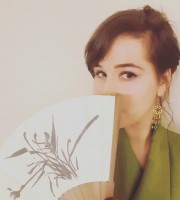




 Next up in our “Mental Health in Japan” series is a limited selection of stories on “madness” as recorded in Japan’s classic literature of the Heian period (794-1185), with a special focus on terminology. I have already written several posts on Heian literature, partly because it was by reading these books that I became fascinated with Japanese culture. I am a huge fan of Sei Shonagon (I recommend her Pillow Book to everyone who wants to explore court life in Japan around the year 1000) and, of course, I should mention Murasaki Shikibu, creator of Japan’s
Next up in our “Mental Health in Japan” series is a limited selection of stories on “madness” as recorded in Japan’s classic literature of the Heian period (794-1185), with a special focus on terminology. I have already written several posts on Heian literature, partly because it was by reading these books that I became fascinated with Japanese culture. I am a huge fan of Sei Shonagon (I recommend her Pillow Book to everyone who wants to explore court life in Japan around the year 1000) and, of course, I should mention Murasaki Shikibu, creator of Japan’s 
